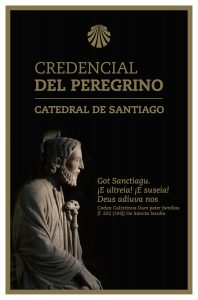The second page of the Credencial is dedicated to clarifying instructions, which reads
Necessary considerations
- This Credencial is only for pilgrims on foot, bicycle or horseback, who wish to make the pilgrimage with a Christian sentiment, even if it is only with an attitude of search. The Credencial has the purpose of identifying the pilgrim; which is why the institution that issues it must be a parish church, confraternity, dioceses, Association of Friends of the Way of St. James, or any Christian institution related to the pilgrimage. The Credencial does not generate any rights to the pilgrim. It has two practical purposes: 1) access to hostels offered by the Christian hospitality of the Way, 2) serve as certification in applying for the “Compostela” at the Cathedral of Santiago, which certifies you have made the pilgrimage.
- The “Compostela” is only granted to those who make the pilgrimage with Christian sentiment: devotionis affectu, voti vel pietatis causa (motivated by devotion, vote or mercy). And it is only granted to those who make the pilgrimage to reach the Tomb of the Apostle, doing in full at least the last 100 kilometres on foot or horseback, or the last 200 km by bike or 100 nautical miles and last km on foot.
- The last 100 km must be done by any of the routes recognized as official by the S. A. M. I. Cathedral of Santiago.
- Therefore, the pilgrim’s Credencial can only be issued by the Church through its institutions (Bishopric, Parish, Confraternity, etc. or, in any case, through institutions that are authorised by the Church). This is the only way the “Compostela” can be awarded at the S.A.M.I. Cathedral of Santiago (Conference on the Holy Year: November 1993).
- Hostels that receive no subsidies must be maintained, within austerity, with contributions from pilgrims (cleaning, looking after facilities, facilitating rest, financial aid…).
- Groups organised with support car or by bicycle are requested to seek alternative shelter to the pilgrim hostels.
- The bearer of this Credencial accepts these conditions.
The remaining pages of the Credencial contain boxes for the stamps along the pilgrimage route. The stamps are normally collected at the places where the pilgrims sleep, such as hostels, but they can also be obtained in parish churches, monasteries, cathedrals, hotels, town halls and other places.
Finally, on the back there are a series of maps of the Ways of St. James, and another page with the following blessing, from the Codex Calixtinus, written in the twelfth century:
Blessing
“In the name of Our Lord Jesus Christ, accept the purse, this symbol of your pilgrimage, that you may be worthy to arrive chastened and cleansed at the threshold of St. James to whom you wish to go; and with your journey completed, may you return safe to us with delight, with Him as a guarantee, Who lives and reigns as God forever and ever, Amen.
Accept this staff as a support for the journey and for the labour on the route of your pilgrimage, so that you may be able to overcome all the throngs of the enemy and arrive secure at the threshold of St. James; and having completed your passage, may you return to us with delight, with the agreement of Him Who lives and reigns as God. World without end.”
(Codex Calixtinus. Sermon “Veneranda dies” LI, c 17th)
Pilgrim’s Prayer
St. James, Apostle, chosen among the first, you were the first to drink the cup of the Master and you are the great protector of pilgrims. Make us strong in faith and happy in hope on our pilgrim journey, following the path of Christian life, and sustain us so that we may finally reach the glory of God the Father. Amen.
Where to get the Official Pilgrim’s Credencial
From the Confraternities of St. James
From authorised Associations in Spain
From authorised Associations worldwide
In Spain: See map
Worldwide: See map



